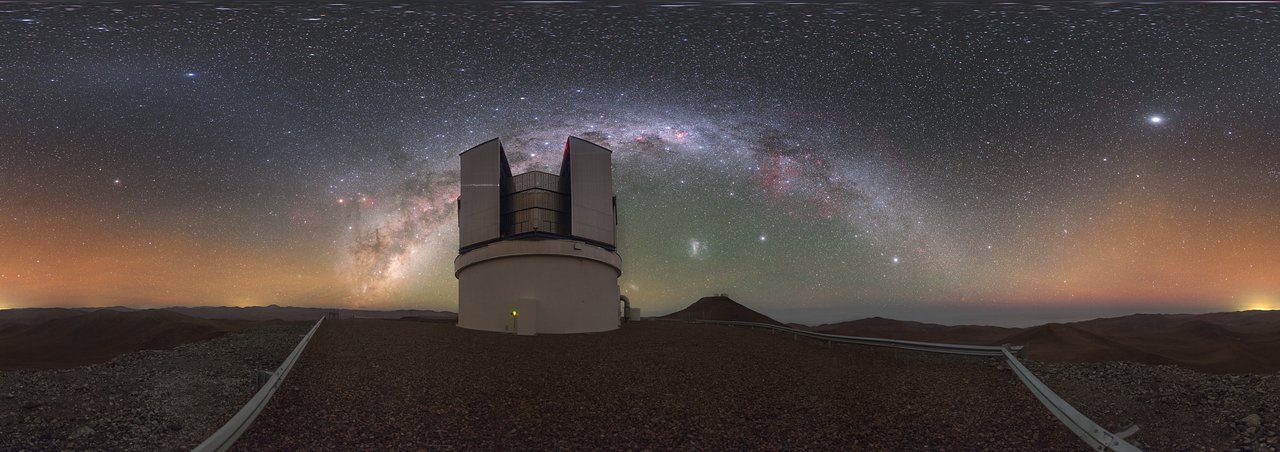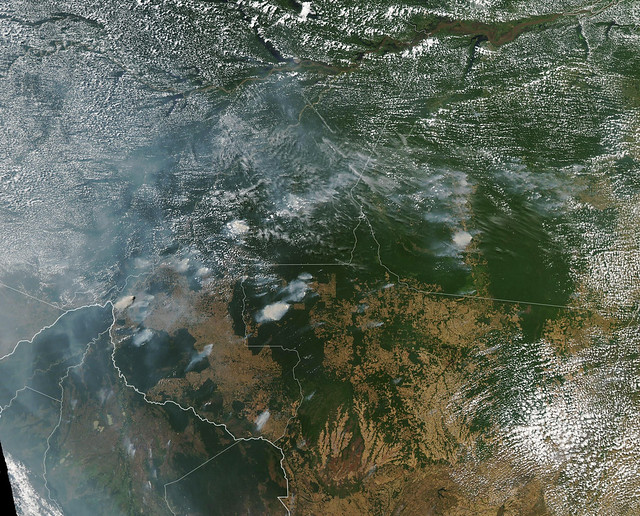Image of the Day 2019 Archive
Explore our Image of the Day 2019 Archives!
August 2019
A Commemorative Coin Returns to Space

Thursday, August 1, 2019: A medallion from the European Astronaut Centre floats in microgravity in front of an Earth-facing window of the International Space Station. ESA astronaut Luca Parmitano tweeted the photo from space this morning. The medallion launches with all European astronauts, Parmitano said, adding that this tradition started after his first mission in 2013. He returned to the orbiting laboratory on July 20. "I took it with me – proudly – for the first time," he said. — Hanneke Weitering
A Spiral Galaxy's Edge

Friday, August 2, 2019: What looks like a long, narrow stretch of stars in this Hubble Space Telescope image is actually a spiral galaxy just like the Milky Way. From our position in the cosmos, we view this galaxy edge-on. Named NGC 3432, this galaxy is located about 45 million light-years from Earth in the constellation of Leo Minor. — Hanneke Weitering
Storms Churn on Jupiter's Horizon

Monday, August 5, 2019: Jupiter's Great Red Spot and a stream of smaller Jovian storms swirl across the planet's south equatorial belt in this new view from NASA's Juno spacecraft. Citizen scientist Kevin Gill created this view using data collected by the spacecraft's JunoCam imager during a close flyby on July 21. At the time, Juno was about 26,697 miles (42,965 kilometers) above Jupiter's cloud tops. — Hanneke Weitering
Happy Birthday, Curiosity!

Tuesday, August 6, 2019: NASA's Curiosity rover, which landed on Mars seven years ago today, took this selfie while making its way up Mount Sharp, a 3-mile (5-kilometer) peak located in the middle of Gale Crater. When Curiosity arrived at the Red Planet in 2012, it touched down inside that same crater. It has since traveled more than 13 miles (21 km), stopping to drill the Martian surface here and there along the way. In this photo, you can see two drill holes near the rover's base. — Hanneke Weitering
Reflections in NASA's Webb Telescope

Wednesday, August 7, 2019: During a recent test of NASA's new James Webb Space Telescope, an engineer snapped this photo of the telescope's enormous primary mirror reflector off its smaller secondary mirror. If you look closely, you can see part of the secondary mirror reflecting off the gold panels that make up the telescope's primary mirror. This photo was taken while NASA engineers were performing a test run of the mechanism that deploys the secondary mirror's support structure. After the telescope launches into space, it will have to perform a series of maneuvers to "unfold" all of its parts. — Hanneke Weitering
The Cat's Paw Nebula

Thursday, August 8, 2019: In honor of International Cat Day, today we share an iconic image of the Cat's Paw Nebula, or NGC 6334, a cosmic cloud of dust and gas with three distinct features shaped like "toe beans." Astronomers with the European Southern Observatory created this image of the nebula using data from the second Digitized Sky Survey back in 2010. You can see more photos of the Cat's Paw Nebula here. — Hanneke Weitering
A 'Seagull' in Space

Friday, August 9, 2019: Flying through the cosmos some 3,400 light-years away from Earth is a bird-shaped cloud of dust and gas known as the Seagull Nebula, or Sharpless 2-296. The European Southern Observatory's VLT Survey Telescope at the Paranal Observatory in Chile captured this new view of the cosmic seagull, which is rich with new star formation. — Hanneke Weitering
Get the Space.com Newsletter
Breaking space news, the latest updates on rocket launches, skywatching events and more!
Milky Way Shines Over VISTA

Monday, August 12, 2019: The arc of the Milky Way galaxy sparkles above the European Southern Observatory's Visible and Infrared Survey Telescope for Astronomy (VISTA) at the Paranal Observatory in Chile in this colorful night-sky photo by astrophotographer Petr Horálek. Barely visible on top of a mountain peak in the background is ESO's Very Large Telescope array. — Hanneke Weitering
Fire and Fireballs Over Macedonia

Tuesday, August 13, 2019: Several bright Perseid meteor dash across the sky near a wildfire in Macedonia in this fisheye view by Stojan Stojanovski. He captured this photo during the peak of the Perseid meteor shower last night. In the center of what appears to be a ring of smoke, the Milky Way galaxy is faintly visible behind four bright meteors, and one smaller meteor can be seen in the distance. — Hanneke Weitering
Andromeda and the Perseids

Wednesday, August 14, 2019: Two meteors dart across the night sky near the Andromeda galaxy, the Milky Way's closest galactic neighbor, in this starry image captured by astrophotographer Omid Qadrdan during the peak of the Perseid meteor shower. Andromeda's tiny satellite galaxy Messier 110 is also visible in this photo, appearing as a fuzzy "star" above and to the left of the galaxy's bright core. — Hanneke Weitering
'Diamond Ring' Over Argentina

Thursday, August 15, 2019: In this timelapse image of the Great South American Eclipse on July 2, the sun sets behind the Andes mountains as the moon crosses directly in front of it, creating a stunning "diamond ring" effect in the evening sky. Astrophotographer Chirag Upreti created this composite using images he captured from Bella Vista, Argentina.
"Totality occurred about 11 degrees above the horizon, and it was emotionally exhilarating to the naked eye, especially because it formed a beautiful connection with the Earth being so close to the horizon," Upreti told Space.com. — Hanneke Weitering
An 'Inky Abyss'

Friday, August 16, 2019: In this new image from the Hubble Space Telescope, what looks like a top-down view of a jellyfish glowing in deep space is actually the planetary nebula NGC 2022. The cosmic orb of ionized gas was expelled from a dying red giant star located at its center. As the star sheds material into space, its core shrinks and grows hotter while emitting ultraviolet radiation that illuminates its gassy shell. — Hanneke
A Tiny Meteor in the Milky Way

Monday, August 19, 2019: Can you spot the meteor in the Milky Way? After taking this photo of the night sky over Mount Rainier in Washington state on July 30, astrophotographer Tony Corso was surprised to find a tiny trail of a meteor near the center of this image. Look for the short streaker on the right edge of the Milky Way's dusty band.
The meteor was likely a member of either the Southern Delta Aquarid meteor shower or the Alpha Capricornids, both of which peaked at the end of July. It could have also been a Perseid meteor, although that shower didn't peak until about two weeks later. — Hanneke Weitering
Hubble Gives Jupiter a Close-Up

Tuesday, August 20, 2019: Jupiter's Great Red Spot and several smaller storms are revealed in intricate detail in this new close-up image from the Hubble Space Telescope. Astronomers used imagery from the telescope's Wide Field Camera 3 to stitch together this flat, stretched-out map of the entire planet. — Hanneke Weitering
Throwback to the Great American Solar Eclipse

Wednesday, August 21, 2019: Two years ago today, a rare coast-to-coast total solar eclipse swept across the continental United States, briefly turning day into night for millions of spectators from Oregon to South Carolina. ESO photographer Petr Horálek created this stunning composite of the moon and the sun's corona during totality by combining many exposures of varying duration. The moon is illuminated by light reflecting off the Earth, and some pink solar prominences are visible around its edge. — Hanneke Weitering
Fires Rage Through the Amazon Rainforest

Thursday, August 22, 2019: Several fires are raging through the Amazon rainforest in Brazil, striking a devastating blow to the ongoing fight against climate change. Environmentalists are blaming the fires on people wanting to create more space for agricultural land. However, this year's fires have reached a record high, increasing by about 80%, according to Brazil's space research center (INPE). NASA's Aqua satellite captured this image of the fires burning through Brazil, as seen from space on August 11. — Passant Rabie
Earth's Glowing, Red Skin

Friday, August 23, 2019: Astronaut Luca Parmitano captured this stunning view of the African continent from the International Space Station, as he marveled at the 'skin of Earth.' The image shows off Africa's red soil, a type of clay enriched with iron and aluminum, which covers large areas of the continent. (However, Parmitano did not specify which part of Africa he was flying over.) — Passant Rabie
Dying Star Sheds Its Outer Layer

Monday, August 26, 2019: Hubble Space Telescope captured this image of a dying star after it shed its outer layers, blasting them off into space. The stellar object confused astronomers at first, who recorded the star as two objects rather than one due to the symmetrical lobes on either of its sides. However, the lobes are formed of expanding clouds of material that are spreading outwards in opposite directions with the star at the center. — Passant Rabie
Smoke Clouds Over Amazon Rainforest

Tuesday, August 27, 2019: As devastating fires continue to sweep through the Amazon rainforest in Brazil, astronaut Luca Parmitano captured a grim view of the smoke from the International Space Station. Parmitano tweeted out the images on August 26, saying that the smoke was visible for thousands of kilometers from the man-made fires. This year's Amazon fires have reached a record high, increasing by about 80% from previous dry seasons, according to Brazil's space research center (INPE). — Passant Rabie
Flying Dragon Sweeps Over Canadian Rocky Mountains

Wednesday, August 28, 2019: Astronaut Christina Koch captured an image of the SpaceX Dragon capsule flying over the Canadian Rocky Mountains on its way back to Earth. The spacecraft departed from the International Space Station on August 27, carrying over a ton of science experiments and other gear to Earth for analysis by NASA staff. — Passant Rabie
Reaching Out to Missions Far From Home

Thursday, August 29, 2019: The European Space Agency's Deep Space Antenna looks out into space, waiting for signals from ongoing missions. The antenna is located in Western Australia, and provides routine support to missions orbiting Mars, the Gaia Observatory and Europe's first mission to Mercury, BepiColombo. — Passant Rabie
Hubble Captures Planetary Nebula in Centaurus Constellation

Friday, August 30, 2019: Located around 10,000 light years away in the constellation Centaurus, a planetary nebula glows in this image by Hubble Space Telescope. A planetary nebula is the final stages in the life of a red giant star, as it ejects layers of ionized gas and the core of the star collapses in on itself. Observing planetary nebulae gives us a glimpse into the future of our own sun. — Passant Rabie
Can't find the date you're looking for? It may have been a weekend or holiday, when we don't normally update our Image of the Day.
Click 'NEXT PAGE' below for September >
Join our Space Forums to keep talking space on the latest missions, night sky and more! And if you have a news tip, correction or comment, let us know at: community@space.com.

Space.com is the premier source of space exploration, innovation and astronomy news, chronicling (and celebrating) humanity's ongoing expansion across the final frontier. Originally founded in 1999, Space.com is, and always has been, the passion of writers and editors who are space fans and also trained journalists. Our current news team consists of Editor-in-Chief Tariq Malik; Editor Hanneke Weitering, Senior Space Writer Mike Wall; Senior Writer Meghan Bartels; Senior Writer Chelsea Gohd, Senior Writer Tereza Pultarova and Staff Writer Alexander Cox, focusing on e-commerce. Senior Producer Steve Spaleta oversees our space videos, with Diana Whitcroft as our Social Media Editor.
